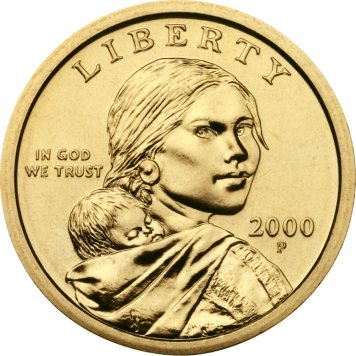Sacagawea Dollar Specifications
The Sacagawea Dollar introduced a new composition developed by the United States Mint to have a distinctive golden color while maintaining the same electromagnetic signature as the previous series. The composition includes a core of pure copper with an outer layer of manganese-brass, consisting of 77% copper, 12% zinc, 7% manganese, and 4% nickel. Including both the core and outer layers, the overall composition is 88.5% copper, 6% zinc, 3.5% manganese, and 2% nickel.
The coins have a diameter of 26.5 mm and weight of 8.1 grams with a plain edge. During the course of the series, coins were struck at the Philadelphia, Denver, and San Francisco Mint facilities. The mint mark location is on the obverse of the coin beneath the date.
In 2009, the Sacagawea Dollar’s design was slightly modified, and it would become referred to by the U.S. Mint as the Native American Dollar going forward. The coin’s composition, diameter, and weight would remain the same. However, the Native American Dollar adopted an incused edge-lettering featuring the corresponding year and mint mark, as well as the inscription “E PLURIBUS UNUM.”
The Native American Dollar would continue featuring Sacagawea on the obverse. However, it would no longer feature the reverse design created by Thomas D. Rogers Sr. Instead, the design would change annually, with each design honoring an important contribution of American Indian tribes or individual Native Americans.
Sacagawea Dollar Coin Specifications
- Obverse Designer: Glenna Goodacre
- Reverse Designer: Thomas D. Rogers Sr.
- Denomination: $1.00
- Composition: 88.5% copper, 6% zinc, 3.5% manganese, 2% nickel
- Diameter: 26.5 mm
- Weight: 8.10 g
- Edge: plain
- Mint Marks: “P” (Philadelphia), “D” (Denver), “S” (San Francisco)


